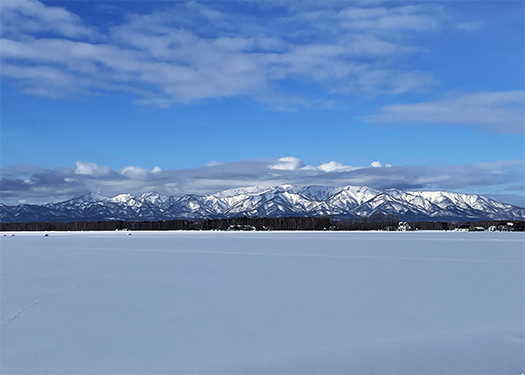
北海道は札幌から旭川までが「道央道」高速道路が走っている大動脈地域。言ってみれば北海道の人口分布の背骨を形成している。けれども実際は北海道全域510万人ほどに対して札幌に200万人近い人口が集中していて、それ以外の地域は急激な人口減少が加速している。札幌にいるとその過密な集中ぶりの中にあって、どちらかといえば、本州地域の関東圏・関西圏と近似した暮らし環境でありそれらと比較すれば住居間の間隔などが広めなので都市環境的いごこち感は高いレベルと思える。しかし、そのちょっと郊外から先には地域の存続可能性が取り沙汰されるエリアが広大に広がっている実態がみえる。
オホーツク地域に根拠地を持つ地域の会社経営者の友人は、歴年にわたって札幌に経済基盤を移行させてきてなんとか会社経営を継続してきたが、やはり徐々に各地域での企業存続について「整理整頓」を図っていかなければならない趨勢。地方経済というものが今後どうなっていくのか、不透明感は強い。
写真のような「冬の景観美」はまことに素晴らしいのだけれど、考えて見ると手前側の平地部分には広大な農業地域が展開していて、冬ごもりしている景観とみなせる。幹線道路沿いには地元の「農家」とおぼしき家屋が点在しているけれど、数件に1軒は積雪に通路も閉ざされたままの「空き家」。離農という選択をせざるを得なかったのだろうかと推測される。
気楽なドライブで地域らしい美感に癒されつつも、一方でこの地に生き続けていく困難ぶりも鋭く突き付けられる思いがしていた。人口減少という日本社会の現実に対して、明治以来、開拓開発に精魂を傾けてきた地域社会には、どのような生き延び方があるのかと考えさせられるのです。
現実的には漁業などでは、海外移民が現実的な選択になってきつつあるのだけれど、より地域密着型である農業にはさてどのような未来形があり得るのか。通りすがりながら、そんな内語を持ち続けていました。
English version⬇
A society with a declining population, as seen in the simple snowy landscape of Hokkaido.
Japan is a society with a declining population, which is reflected in the beauty of its tranquil and beautiful landscapes. The reality of Hokkaido, a region at the forefront of this trend. How do we deal with this accelerating trend? …
Hokkaido is a major arterial region with the ‘Hokkaido Expressway’ highway running from Sapporo to Asahikawa. In other words, it forms the backbone of Hokkaido’s population distribution. In reality, however, nearly 2 million people are concentrated in Sapporo, compared to 5.1 million in the whole of Hokkaido, and the rest of the country is experiencing a rapid decline in population. In Sapporo, the overcrowded concentration of people makes the living environment more similar to that of the Kanto and Kansai regions of Honshu, and the spacing between dwellings is wider than in those areas, so the urban environment seems to have a high level of comfort. However, the reality is that beyond the suburbs there is a vast area where the viability of the area is being discussed.
A friend of mine who runs a company based in the Okhotsk region has managed to keep his company running by shifting the economic base to Sapporo over the years, but the trend is to gradually ‘tidy up’ the survival of companies in each region. There is a strong sense of uncertainty about the future of the local economy.
The ‘beauty of the winter landscape’ in the picture is truly wonderful, but when you think about it, the flat land in the foreground is a vast agricultural area and can be regarded as a winter shelter. There are houses along the main road that look like local ‘farmhouses’, but one in several of them is empty, with the passageway blocked by snow. It is assumed that they had no choice but to leave farming.
While I was healed by the beauty of the region on an easy drive, I was also sharply reminded of the difficulties of continuing to live in this area. Against the reality of Japanese society’s declining population, one wonders what kind of survival options are available to local communities that have devoted their energies to pioneering development since the Meiji era.
In reality, overseas immigration is becoming a realistic option for the fishing industry, but what kind of future is possible for agriculture, which is more community-based? As I passed by, I kept having these internal thoughts.
Posted on 1月 16th, 2025 by 三木 奎吾
Filed under: 日本社会・文化研究







コメントを投稿
「※誹謗中傷や、悪意のある書き込み、営利目的などのコメントを防ぐために、投稿された全てのコメントは一時的に保留されますのでご了承ください。」
You must be logged in to post a comment.